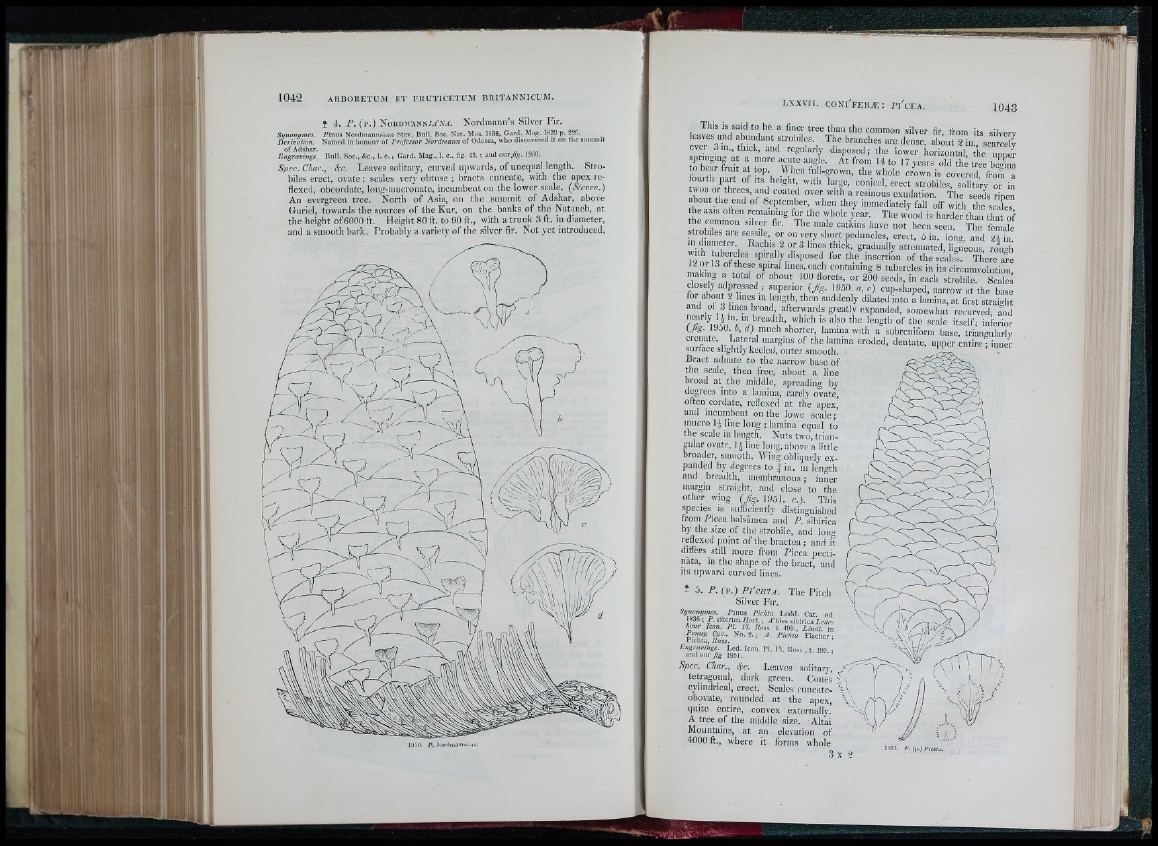
1 4 . V . ( p . ) N o r d i i a n n * ' * . Nordmimn’s Silver Fir.
Siinonyntcs. P in u s Nordmannu/«« Stev. Bull. Soc. Nat. Mtis. 1638, Gard. Mag. 1839 p. 226.
Derivation. Named in honour of Professor Nordmann of Odessa, who discovered it on trie suininit
of Adshar. ^
Engravings. Bull. Soc., &c., 1. c. j Card. Mag., 1. c., fig. 43. ; and o u r /g . 1950.
Spec. Char., 4c. Leaves solitaiy, curved upwai-ds, of unequal length. Strobiles
erect, ovate ; scales very obtuse ; liracts cuneate, with the apex reflexed,
obcordate, long-nmcronate, incumbent on tbe lower scale. (Sieven.)
An evergreen tree. North of Asia, on the summit of Adshar, above
(iuriel, towards the sources of the Kur, on the banks of the Nataneb, at
the height of 6000 ft. Height 80 ft. to 90 ft., with a trunk S ft. in diameter,
and a smooth bark. Probably a variety of the silver iir. Not yet introduced.
I'JoO. P. Norclinaiiiiiù/iii.
L X X V I I . c o n i ' f e r æ : p i ' c e a . 1 0 4 3
This IS said to be a finer tree than the common silver fir from its silvpi-v
leaves and abundant strobiles. The branches are dense, ab;]! 2"n s c m S
Yrin »"fo regulmly disposed; the lower horizontal, the iipne!
springing at a more acute angle. At from 14 to 17 years old the tree beffins
fouYh'Ytel f the whole crown is covered, from a
tTos or tl Í *t® fo®>gfot> with large, conical, erect strobiles, solitary or in
twos or threes, and coated over with a resinous exudation. The seeds rinen
about the end of September, when they immediately fall off with the scafes
h! teotete ’ 'fo® T'"'® ^®fo- '^'fo® *°°the common silver fir. The male catkins have not bfeoe n sfoe»e'-nfo.® ‘' The tfhe»mt aolef
stiobiles are sessile, or ou very short peduncles, erect, 5 in. long, and 2 i in
teithTi'h 1 ^ fo"®.® attenuated, ligneous, rorigh
i n f f îY y,fo‘®P«®®‘> for the insertion of the scales. There are
J -or id ot these spiral lines, each containing 8 tubercles in its circumvolution
making a total ot about 1 0 0 florets, or 2 0 0 seeds, in each strobile. Scales
closely adpressed ; superior (fig . 1950. a, c) cup-shaped, na.Tow at the base
for about 2 lines m length, then suddenly dilated into a lamina, at first strai"ht
i f '®7 ®;'fo"te®fo'î'®''P“ fo®fo’ »oiuewhat recurved, and
CW t e o r i '¿ t e l I ’ , " f o ' ® f o ‘fo® length of the scale itself; inferior
(Jig- lyoo 6 , ÍÍ) much shorter, lamina with a subreniform base, triangularlv
crenate. Lateral margins of the lamina eroded, dentate, upper entire T inner
surface slightly keeled, outer smooth. " "t"® >'“ >«
Bract adnate to the narrow base of
the scale, then free, about a line
broad at the middle, spreading by
degrees into a lamina, rarely ovate,
often cordate, reflexed at the apex,
and incumbent on the lowe scale;’
mucro IJ line long ; lamina equal to
the scale in length. Nuts two, triangular
ovate, 1| line long, above a little
broader, smooth. Wing obliquely expanded
by degrees to J in. in length
and breadth, membranous ; inner
margin straight, and close to the
other wing (fig . 1951. c.). This
species^ is sufficiently distinguished
from rticea balsàmea and P. sibirica
by the size of the strobile, and long
reflexed point of the bractea ; and it
differs still more from Pícea pectinata,
in the shape of the bract, and
its upward curved lines.
Î 5. P. (p.) Pi'cHTA. The Pitch
Silver Fir.
Synonymes. Blnus Plc/ita Lodd. Cat. ed
1836; P . s ib in c a i/e r i. ; A'bies sibirica Lede-
io u r Icon. P l. n . Ross. I. 499., L inM. in
"■ fr“ '»
Engravings. Led. Icon. PI. Fl. lio.ss., t. 499. ;
and o n r * 1951.
Spec. Char., f r . Leaves .sohtary, A/
tetragonal, dark green. Cones s
cylindrical, erect. Scales cuneate- \ ,
obovate, rounded at the apex, \ \
quite entire, convex externally.
A tree of the middle size. Altai
Mountains, at an elevation of
4000 ft., where it forms whole
3 x 2